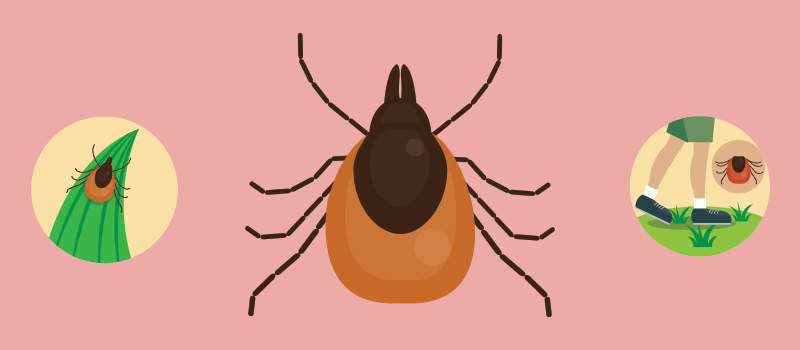What’s the Buzz
The Bee Healthy Blog
What Do Ticks Look Like? How to Identify a Tick Bite?

Ticks are tiny, blood-sucking parasites that are commonly found in wooded areas. Most tick bites don’t cause any problems. However, some tick bites can cause tick-borne diseases that can be dangerous or even life-threatening if not treated. Some 50,000 Americans suffer from tick bites every year. This article will help you recognize tick bites, learn to prevent tick bites, and keep yourself safe from tick-borne illnesses.
What are tick-borne diseases?
Ticks carry diseases between animals and humans–they are vectors and transmit diseases by passing germs like bacteria and viruses between hosts. Germs in the tick saliva can enter the host’s blood after a tick bite and lead to a tick-borne infection.
It is not worth noting that not all tick bites cause a tick-borne disease. Also, sometimes you may be able to remove a tick before it can pass on any germs.
Examples of some tick-borne diseases include:
- Lyme disease
- Rocky Mountain Spotted Fever
- Tularemia
- Anaplasmosis
- Babesiosis
- Ehrlichiosis
Ticks can also transmit pathogens and cause tick-borne illnesses such as:
- Southern tick-associated rash illness (STARI)
- Heartland virus
- Powassan virus
- Colorado tick fever
- Relapsing fever
- Spotted fever
- Tick paralysis
What do ticks look like?
Ticks are arachnids (they are related to spiders and scorpions). They have eight legs and are reddish-brown or black in color, sometimes with light markings. Ticks range in size from a pinhead to a pencil eraser.
Ticks are small and difficult to see until they’ve been attached to your skin for some time. After sucking on blood, ticks can grow as large as marble-sized and appear greenish-blue in color.
Tick species common in the US include black-legged or deer ticks, lone star ticks, and dog ticks (common ticks include the American dog tick, brown dog tick, and Amazon dog tick).
What does an early tick bite look like?
Most people don’t realize a tick has bitten them. That’s because, unlike a mosquito bite or other insect bites, tick bites don’t cause pain or itching. Sometimes, a tick bite can cause a skin reaction, such as a rash or small lump.
Signs and symptoms of tick-borne disease can include flu-like symptoms (fever, chills, headache, muscle aches, fatigue), itching, irritation, and skin rash.
What does a Lyme tick bite look like?
The type of rash caused by a tick bite can provide a clue to the tick-borne illness. For example, a characteristic Lyme tick bite is a solid red oval with a central spot or bull’s eye surrounded by a clear area and a wider red circle. The bull’s eye rash caused by a Lyme tick bite is usually flat and does not itch but can expand over time. A similar bullseye rash occurs with southern tick-associated rash illness (STARI). This type of bull's eye rash is also called the Lone Star tick rash.
In Rocky Mountain Spotted Fever, petechiae (small purplish-red spots) can develop. Some tick bite rashes are non-specific red blotches and can be difficult to identify.
What happens when a tick bites you?
Ticks typically bite on exposed areas of the skin, such as the arms and legs. However, they prefer warm, moist areas of the body with a lot of blood. Therefore, ticks can migrate from the bite site to places such as the backs of the knees, groin, belly button, waist, armpits, ears, and hair.
Remember that ticks may not migrate, i.e., they may remain attached to the bite area. So, if you think a tick might have bitten you, it’s important to check your entire body and try to find the tick attached to your skin.
After a tick reaches the desired spot, it bites once, draws blood, and remains attached to the skin. You don’t typically feel the bite when it is occurring. After about 10 days of sucking blood, the engorged tick falls off on its own.
What to do if you get bitten by a tick?
Ticks should be removed firmly but carefully with blunt tweezers. Do not use a cigarette butt, kerosene, or petroleum jelly (Vaseline) for tick removal. Grasp the tick near the head and tug on it until it detaches from your skin. Do not remove ticks with bare hands or squeeze the tick’s body, as this can transfer germs. After removing the tick, wash the area with soap and water.
You should contact your healthcare provider immediately after a tick bite. Your doctor may want to refer you to an infectious disease specialist. Sometimes, treatment for a vector-borne disease like Lyme disease may be started soon after a tick bite even if you don’t have symptoms.
Be sure to seek medical attention if you find a tick that may have been attached for several hours or days, if you see a rash at the bite site or in other parts of your body, or if you develop pain, blisters, flu-like symptoms, or any other symptoms.
How can I reduce my risk of getting a tick bite?
If you live in a tick-infested area, heavily wooded area, or participate in outdoor activities, especially during tick season (spring and summer months), some simple precautions can protect you from tick bites and other bug bites. These include:
- Wearing light-colored and long-sleeved clothing in tightly-woven fabrics.
- Tucking pants into your socks or boots.
- Staying near the center of trails.
- Mowing your lawn regularly.
- Using insect repellents on exposed skin.
- Wearing clothes treated with permethrin.
- Check your body for ticks when you come in from outside.
- Take a shower after working in the yard or hiking in the woods.
- Checking your clothes and gear for ticks and wash them immediately (a 15-minute cycle in the dryer will kill ticks).
- Checking your pets and using tick prevention products for pets.
References:


SOCIAL